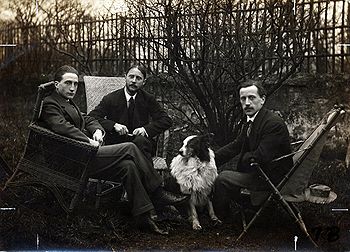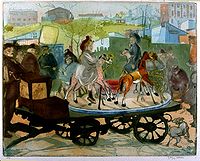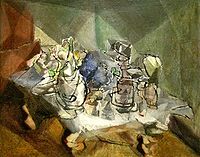
Jacques Villon
Encyclopedia


Early life
Born Gaston Emile Duchamp in DamvilleDamville
Damville is a commune in the Eure Department in the Haute-Normandie region in northern France.-Population:-History:Damville was important for its situation on the Norman border.The fortress of Damville was built in 1035...
, Eure
Eure
Eure is a department in the north of France named after the river Eure.- History :Eure is one of the original 83 departments created during the French Revolution on 4 March 1790...
, in the Haute-Normandie
Haute-Normandie
Upper Normandy is one of the 27 regions of France. It was created in 1984 from two départements: Seine-Maritime and Eure, when Normandy was divided into Lower Normandy and Upper Normandy. This division continues to provoke controversy, and some continue to call for reuniting the two regions...
region of France, he came from a prosperous and artistically inclined family. While he was a young man, his maternal grandfather Emile Nicolle, successful businessman and artist, taught him and his siblings.
Gaston Duchamp was the elder brother of:
- Raymond Duchamp-VillonRaymond Duchamp-VillonRaymond Duchamp-Villon was a French sculptor.Duchamp-Villon was born Pierre-Maurice-Raymond Duchamp in Damville, Eure, in the Haute-Normandie region of France, the second son of Eugene and Lucie Duchamp. Of the six Duchamp children, four would become successful artists...
(1876-1918), sculptor - Marcel DuchampMarcel DuchampMarcel Duchamp was a French artist whose work is most often associated with the Dadaist and Surrealist movements. Considered by some to be one of the most important artists of the 20th century, Duchamp's output influenced the development of post-World War I Western art...
(1887-1968), painter, sculptor and author - Suzanne Duchamp-CrottiSuzanne DuchampSuzanne Duchamp-Crotti was a French Dadaist painter. Born in Blainville-Crevon, Seine-Maritime in the Haute-Normandie Region of France, she was the fourth of six children born into the artistic family of Eugene and Lucie Duchamp.Suzanne Duchamp-Crotti was the younger sister of:*Jacques Villon née...
(1889-1963), painter
In 1894, he and his brother Raymond moved to the Montmartre
Montmartre
Montmartre is a hill which is 130 metres high, giving its name to the surrounding district, in the north of Paris in the 18th arrondissement, a part of the Right Bank. Montmartre is primarily known for the white-domed Basilica of the Sacré Cœur on its summit and as a nightclub district...
area of Paris. There, he studied law at the University of Paris
University of Paris
The University of Paris was a university located in Paris, France and one of the earliest to be established in Europe. It was founded in the mid 12th century, and officially recognized as a university probably between 1160 and 1250...
but received his father's permission to study art on the condition that he continue studying law.
To distinguish himself from his siblings, Gaston Duchamp adopted the pseudonym of Jacques Villon as a tribute to the French medieval poet François Villon
François Villon
François Villon was a French poet, thief, and vagabond. He is perhaps best known for his Testaments and his Ballade des Pendus, written while in prison...
. In Montmartre, home to an expanding art community, Villon lost interest in the pursuit of a legal career, and for the next 10 years he worked in graphic media, contributing cartoons and illustrations to Parisian newspapers as well as drawing color posters.
In 1903 he helped organize the drawing section of the first Salon d'Automne
Salon d'Automne
In 1903, the first Salon d'Automne was organized by Georges Rouault, André Derain, Henri Matisse, Angele Delasalle and Albert Marquet as a reaction to the conservative policies of the official Paris Salon...
in Paris. In 1904-1905 he studied art at the Académie Julian
Académie Julian
The Académie Julian was an art school in Paris, France.Rodolphe Julian established the Académie Julian in 1868 at the Passage des Panoramas, as a private studio school for art students. The Académie Julian not only prepared students to the exams at the prestigious École des Beaux-Arts, but offered...
.
During the First World War, Villon worked as a cartographer for the army.
At first, he was influenced by Edgar Degas
Edgar Degas
Edgar Degas[p] , born Hilaire-Germain-Edgar De Gas, was a French artist famous for his work in painting, sculpture, printmaking and drawing. He is regarded as one of the founders of Impressionism although he rejected the term, and preferred to be called a realist...
and Henri de Toulouse-Lautrec
Henri de Toulouse-Lautrec
Henri Marie Raymond de Toulouse-Lautrec-Monfa or simply Henri de Toulouse-Lautrec was a French painter, printmaker, draughtsman, and illustrator, whose immersion in the colourful and theatrical life of fin de siècle Paris yielded an œuvre of exciting, elegant and provocative images of the modern...
, but later he participated in the fauvist
Fauvism
Fauvism is the style of les Fauves , a short-lived and loose group of early twentieth-century Modern artists whose works emphasized painterly qualities and strong colour over the representational or realistic values retained by Impressionism...
, cubist
Cubism
Cubism was a 20th century avant-garde art movement, pioneered by Pablo Picasso and Georges Braque, that revolutionized European painting and sculpture, and inspired related movements in music, literature and architecture...
, and abstract impressionist
Abstract impressionism
Abstract Impressionism is a type of abstract painting where small brushstrokes build and structure large paintings...
movements.
By 1906, Montmartre was a bustling community and Jacques Villon moved to Puteaux
Puteaux
Puteaux is a commune in the western suburbs of Paris, France. It is located in the heart of the Hauts-de-Seine department from the center of Paris....
in the quiet outskirts of Paris. There, he began to devote more of his time to working in drypoint
Drypoint
Drypoint is a printmaking technique of the intaglio family, in which an image is incised into a plate with a hard-pointed "needle" of sharp metal or diamond point. Traditionally the plate was copper, but now acetate, zinc, or plexiglas are also commonly used...
, an intaglio
Intaglio (printmaking)
Intaglio is a family of printmaking techniques in which the image is incised into a surface, known as the matrix or plate, and the incised line or area holds the ink. Normally, copper or zinc plates are used as a surface, and the incisions are created by etching, engraving, drypoint, aquatint or...
technique that creates dark, velvety lines that stand out against the white of the paper. During this time he worked closely to develop his technique with other important printmakers such as Manuel Robbe.
His isolation from the vibrant art community in Montmartre, together with his modest nature, ensured that he and his artwork remained obscure for a number of years.

Francis Picabia
Francis Picabia was a French painter, poet, and typographist, associated with both the Dada and Surrealist art movements.- Early life :...
, Robert Delaunay
Robert Delaunay
Robert Delaunay was a French artist who, with his wife Sonia Delaunay and others, cofounded the Orphism art movement, noted for its use of strong colours and geometric shapes. His later works were more abstract, reminiscent of Paul Klee...
, Fernand Léger
Fernand Léger
Joseph Fernand Henri Léger was a French painter, sculptor, and filmmaker. In his early works he created a personal form of Cubism which he gradually modified into a more figurative, populist style...
and others that was soon dubbed the Puteaux Group. Villon was instrumental in having the group exhibit under the name Section d'Or after the "golden section" of classical mathematics. Their first show at La Botie gallery in October 1912 involved more than 200 works by 31 artists.
In 1913, Villon created his cubist masterpieces — seven large drypoints in which forms break into shaded pyramidal planes. That year, he exhibited at the famous Armory Show
Armory Show
Many exhibitions have been held in the vast spaces of U.S. National Guard armories, but the Armory Show refers to the 1913 International Exhibition of Modern Art that was organized by the Association of American Painters and Sculptors...
in New York City that helped introduce European modern art to the United States. His works proved popular and all his art sold. From there, his reputation expanded so that by the 1930s he was better known in the United States than in Europe.
In May 2004, an oil painting by Villon dated 1913 entitled "L'Acrobate" and measuring 39 ¼ by 28 ¼ inches sold at Sotheby's
Sotheby's
Sotheby's is the world's fourth oldest auction house in continuous operation.-History:The oldest auction house in operation is the Stockholms Auktionsverk founded in 1674, the second oldest is Göteborgs Auktionsverk founded in 1681 and third oldest being founded in 1731, all Swedish...
for $1,296,000 (US dollars).
Honors
An exhibition of Jacques Villon's work was held in Paris in 1944 at the Galerie Louis Carré, following which he received honors at a number of international exhibitions. In 1950, Villon received the Carnegie PrizeCarnegie Prize
The Carnegie Prize is an international prize for artists, awarded by the Carnegie Museum of Art in Pittsburgh, Pennsylvania.The prize should not be confused with the Carnegie Medal, which is awarded for children's literature....
, the highest award for painting in the world, and in 1954 he was made a Commander of the Legion of Honor. The following year he was commissioned to design stained-glass windows for the cathedral at Metz
Metz
Metz is a city in the northeast of France located at the confluence of the Moselle and the Seille rivers.Metz is the capital of the Lorraine region and prefecture of the Moselle department. Located near the tripoint along the junction of France, Germany, and Luxembourg, Metz forms a central place...
, France. In 1956 he was awarded the Grand Prix at the Venice Biennale
Venice Biennale
The Venice Biennale is a major contemporary art exhibition that takes place once every two years in Venice, Italy. The Venice Film Festival is part of it. So too is the Venice Biennale of Architecture, which is held in even years...
exhibition.
Among Villon's greatest achievements as a printmaker was his creation of a purely graphic language for cubism — an accomplishment that no other printmaker, including his fellow cubists Pablo Picasso
Pablo Picasso
Pablo Diego José Francisco de Paula Juan Nepomuceno María de los Remedios Cipriano de la Santísima Trinidad Ruiz y Picasso known as Pablo Ruiz Picasso was a Spanish expatriate painter, sculptor, printmaker, ceramicist, and stage designer, one of the greatest and most influential artists of the...
or Georges Braque
Georges Braque
Georges Braque[p] was a major 20th century French painter and sculptor who, along with Pablo Picasso, developed the art style known as Cubism.-Early Life:...
, could claim.
Villon died in his studio at Puteaux
Puteaux
Puteaux is a commune in the western suburbs of Paris, France. It is located in the heart of the Hauts-de-Seine department from the center of Paris....
.
In 1967, in Rouen
Rouen
Rouen , in northern France on the River Seine, is the capital of the Haute-Normandie region and the historic capital city of Normandy. Once one of the largest and most prosperous cities of medieval Europe , it was the seat of the Exchequer of Normandy in the Middle Ages...
, his last surviving artist brother Marcel helped organize an exhibition called Les Duchamp: Jacques Villon, Raymond Duchamp-Villon, Marcel Duchamp, Suzanne Duchamp. Some of this family exhibition was later shown at the Musée National d'Art Moderne
Musée National d'Art Moderne
The Musée National d'Art Moderne is the national museum for modern art of France. It is located in Paris and is housed in the Centre Pompidou in the 4th arrondissement of the city. Created in 1947, it was then housed in the Palais de Tokyo and moved to its current location in 1977...
in Paris.
Many important museums include works by Villon in their collections, including: Fine Arts Museums of San Francisco
Fine Arts Museums of San Francisco
The Fine Arts Museums of San Francisco, comprising the M. H. de Young Memorial Museum in Golden Gate Park and the California Palace of the Legion of Honor in Lincoln Park, is the largest public arts institution in the city of San Francisco and one of the largest art museums in California.-External...
; Minneapolis Institute of Arts
Minneapolis Institute of Arts
The Minneapolis Institute of Arts is a fine art museum located in the Whittier neighborhood of Minneapolis, Minnesota, on a campus that covers nearly 8 acres , formerly Morrison Park...
, Museum of Fine Arts, Boston
Museum of Fine Arts, Boston
The Museum of Fine Arts in Boston, Massachusetts, is one of the largest museums in the United States, attracting over one million visitors a year. It contains over 450,000 works of art, making it one of the most comprehensive collections in the Americas...
; MOMA
Moma
Moma may refer to:* Moma , an owlet moth genus* Moma Airport, a Russian public airport* Moma District, Nampula, Mozambique* Moma River, a right tributary of the Indigirka River* Google Moma, the Google corporate intranet...
, New York City;, The University of Michigan Collection; The National Gallery of Art
National Gallery of Art
The National Gallery of Art and its Sculpture Garden is a national art museum, located on the National Mall between 3rd and 9th Streets at Constitution Avenue NW, in Washington, DC...
, Washington D.C.; the Art Gallery of New South Wales
Art Gallery of New South Wales
The Art Gallery of New South Wales , located in The Domain in Sydney, New South Wales, Australia, was established in 1897 and is the most important public gallery in Sydney and the fourth largest in Australia...
, Sydney, Australia; La Bibliothèque Nationale in Paris; and Musee Jenisch
Musée Jenisch
The Musée Jenish is a museum of fine arts and prints at Vevey in Vaud in Switzerland. It was set up on 10 March 1897, thanks to a legacy of 200,000 francs from Fanny Henriette Jenisch , wife of Martin Johan Jenisch, a senator of Hamburg. It was designed in the neo-classical style by the architect...
, Vevey, Switzerland. Leading private collections which include the works of Villon are the Joachim Collection of Chicago, the Vess Collection of Detroit, and the Ginestet Collection of Paris.
External links
- Francis Steegmuller Collection of Jacques Villon. General Collection, Beinecke Rare Book and Manuscript LibraryBeinecke Rare Book and Manuscript LibraryYale University's Beinecke Rare Book and Manuscript Library was a 1963 gift of the Beinecke family. The building was designed by architect Gordon Bunshaft of the firm of Skidmore, Owings, and Merrill, and is the largest building in the world reserved exclusively for the preservation of rare books...
, Yale UniversityYale UniversityYale University is a private, Ivy League university located in New Haven, Connecticut, United States. Founded in 1701 in the Colony of Connecticut, the university is the third-oldest institution of higher education in the United States...
. - Artcyclopedia Links to Villon's works
- Jacques Villon.info

